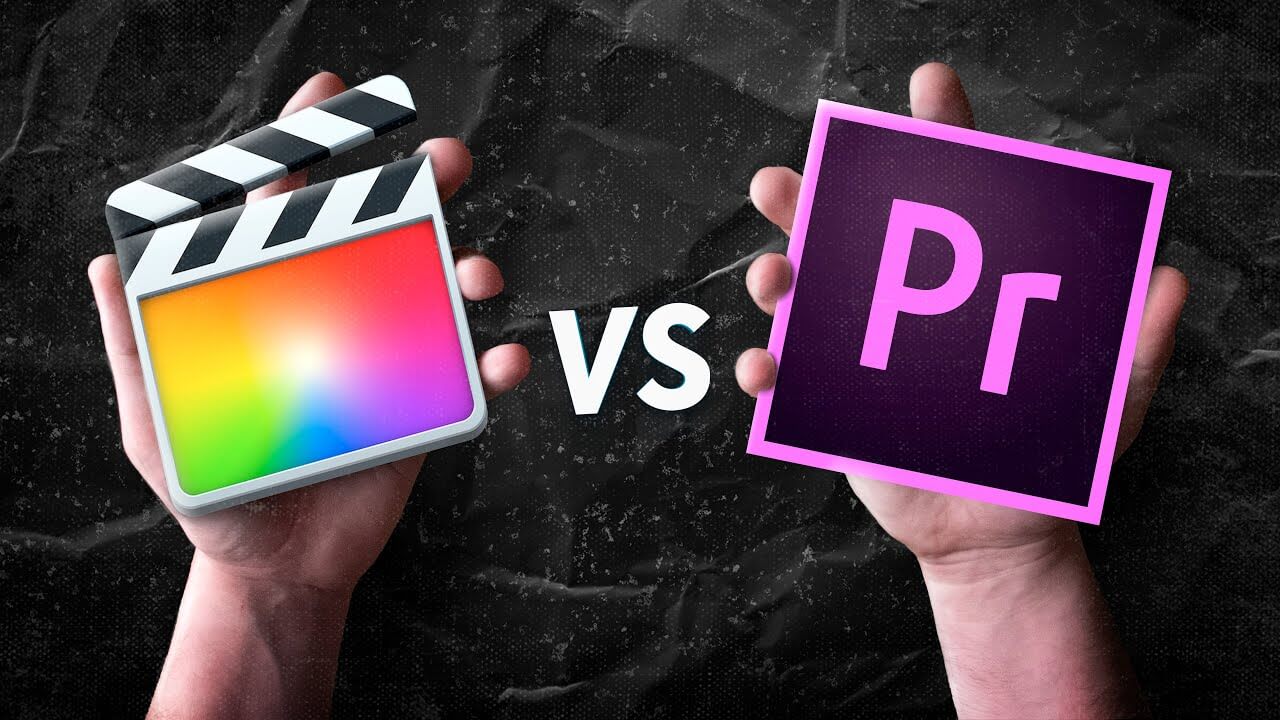Final Cut Pro and Premiere Pro are the two most popular video editing platforms for film professionals. Apple and Adobe have been battling for market share in the video editing software industry for decades, and there are no signs of them slowing down anytime soon. So – Final Cut Pro vs Adobe Premiere Pro: which is better? We’re going to look at the pricing, utility, ease of use, and more of Final Cut Pro and Adobe Premiere Pro in order to give you an answer to that question. By the end, you’ll know which video editing program makes the most sense for your workflow needs.
Final Cut vs Premiere Breakdown
Final Cut Pro vs Premiere Pro OS compatibility and system requirements
Before you buy Adobe Premiere Pro or Final Cut Pro, you should make sure whichever software you choose is going to be compatible with your computer’s operating system. So, let’s compare Adobe Premiere and Final Cut Pro.
- Adobe Premiere Pro works with Microsoft Windows and Apple Mac OS
- Final Cut Pro is only compatible with Mac OS
If you value OS flexibility, then Premiere Pro offers the best value. With Adobe Creative Cloud, you receive two licenses for product use, so if you have a desktop PC and a Macbook Pro, you can use Premiere Pro on two separate operating systems — at home and on-the-go.
But remember, Apple built Final Cut Pro from the ground up, specifically for Mac OS. As such, it shouldn’t come as a surprise that Final Cut Pro makes better use of integrated OS features and generally seems more “fine-tuned” for Mac use.
Listen to two professional video editors explain why they prefer one program over the other below:
Final Cut Pro vs Adobe Premiere Pro Analysis
You should also make sure to check the system requirements for running Final Cut Pro and Adobe Premiere Pro.
Here are the system requirements for running Premiere Pro on Windows:
System requirements for Premiere Pro
Premiere Pro on Windows
| Minimum specifications | Recommended specifications |
Processor | Intel® 6thGen or newer CPU – or AMD equivalent | Intel® 7thGen or newer CPU – or AMD equivalent |
Operating system | Microsoft Windows 10 (64-bit) version 1803 or later | Microsoft Windows 10 (64-bit) version 1809 or later |
RAM | 8 GB of RAM | 16 GB of RAM for HD media 32 GB for 4K media or higher |
GPU | 2 GB of GPU VRAM For a list of recommended graphic cards, see Recommended graphics cards for Adobe Premiere Pro. | 4 GB of GPU VRAM For a list of recommended graphic cards, see Recommended graphics cards for Adobe Premiere Pro. |
Hard disk space | 8 GB of available hard-disk space for installation; additional free space required during installation (will not install on removable flash storage) Additional high-speed drive for media | Fast internal SSD for app installation and cache Additional high-speed drive(s) for media |
Monitor resolution | 1280 x 800 | 1920 x 1080 or greater |
Sound card | ASIO compatible or Microsoft Windows Driver Model | ASIO compatible or Microsoft Windows Driver Model |
Network storage connection | 1 Gigabit Ethernet (HD only) | 10 Gigabit ethernet for 4K shared network workflow |
Internet | Internet connection and registration are necessary for required software activation, validation of subscriptions, and access to online services.* | |
Here are the system requirements for running Premiere Pro on Mac OS:
Premiere Pro on macOS
| Minimum specifications | Recommended specifications |
Processor | Intel® 6thGen or newer CPU | Intel® 6thGen or newer CPU |
Operating system | macOS v10.13 or later | macOS v10.13 or later |
macOS v10.13 or laterRAM | 8 GB of RAM | 16 GB of RAM for HD media 32 GB for 4K media or higher |
GPU | 2 GB of GPU VRAM | 4 GB of GPU VRAM |
Hard disk space | 8 GB of available hard-disk space for installation; additional free space required during installation (will not install on a volume that uses a case sensitive file system or on removable flash storage devices). Additional high-speed drive for media | Fast internal SSD for app installation and cache Additional high-speed drive(s) for media |
Monitor resolution | 1280 x 800 | 1920 x 1080 or greater |
Network storage connection | 1 Gigabit Ethernet (HD only) | 10 Gigabit ethernet for 4K shared network workflow |
Internet | Internet connection and registration are necessary for required software activation, validation of subscriptions, and access to online services.* | |
All in all, it’s hard to ignore the better OS flexibility of Premiere Pro.
Overall Winner: Adobe Premiere Pro
Adobe Premiere vs Final Cut
Final Cut Pro vs Premiere Pro pricing
One of the most important parts of the “Final Cut Pro vs Adobe Premiere Pro” debate is pricing. There’s not only a massive difference in the price of these two products, but a massive difference in HOW these products are priced. Final Cut Pro is a “one-time purchase,” currently priced at $299.99.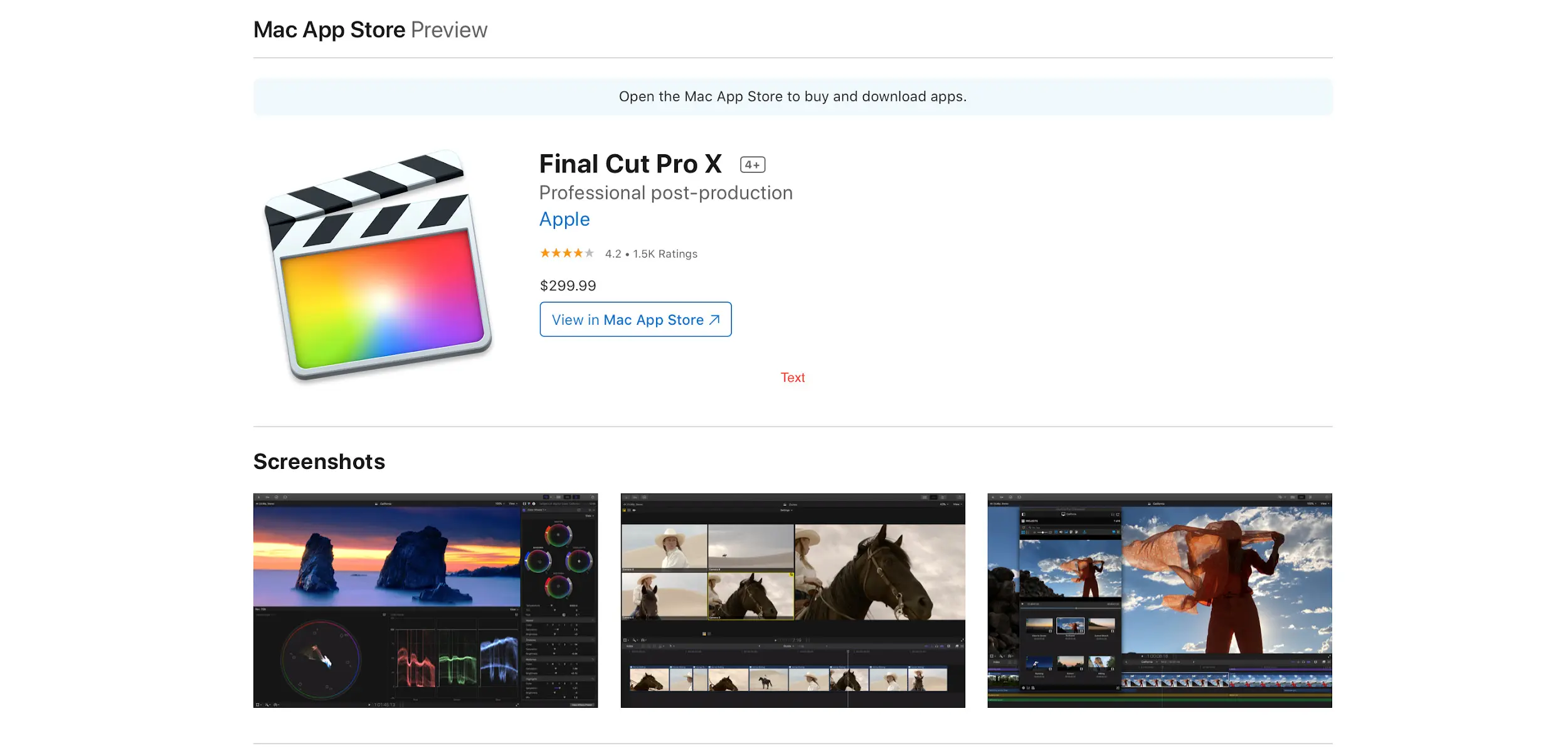
Adobe Premiere Pro vs Final Cut Pro X Pricing
Although Final Cut Pro isn’t updated as much as Adobe Premiere Pro is, the updates that do come, come free of charge. So there are two major benefits to the price of Final Cut Pro:
- One time purchase
- You own the software forever
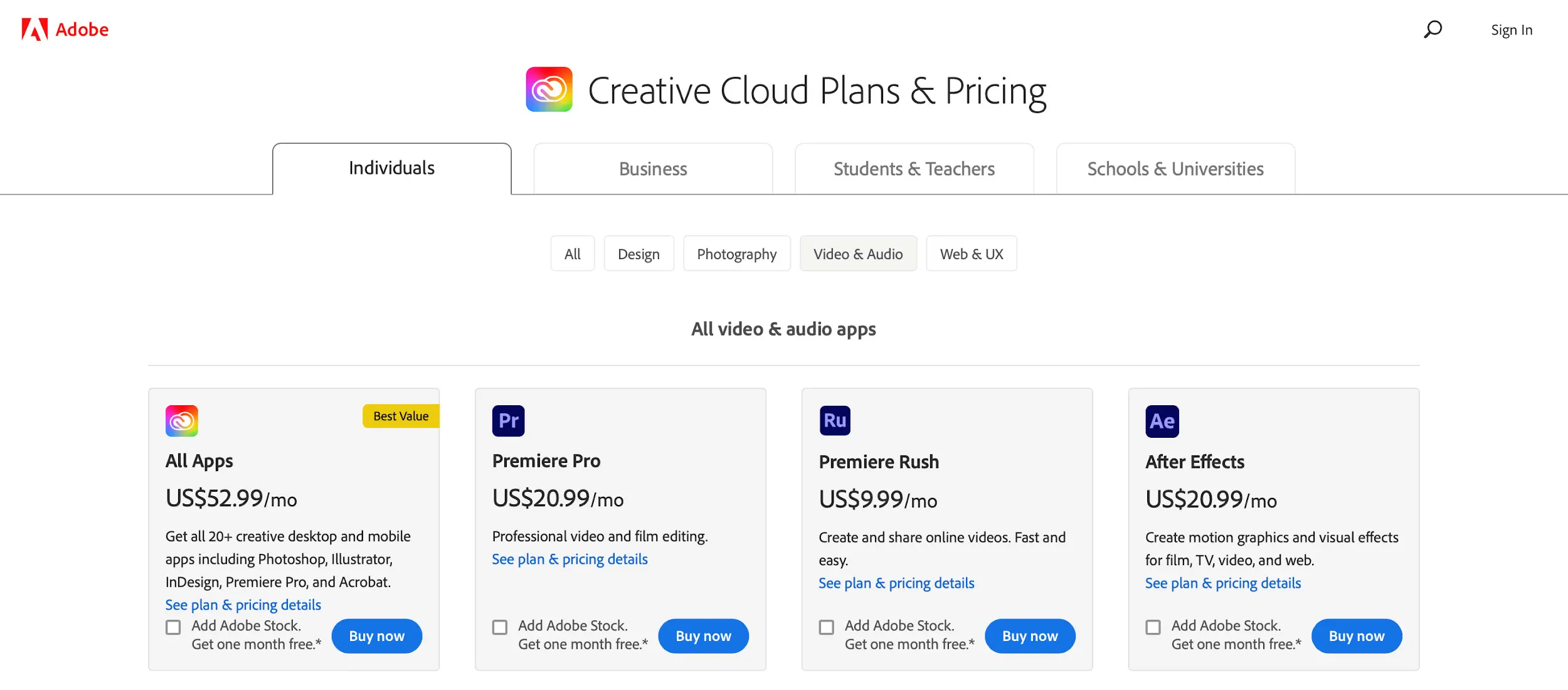
Adobe Premiere Pro vs Final Cut Pro X • Creative Cloud Pricing
As of writing, these are the costs of a Premiere Pro subscription:
- $20.99 annual plan, paid monthly
- $31.49 monthly plan
- $239.88 annual plan prepaid
You can also use Premiere Pro if you subscribe to Adobe’s Creative Cloud. Although CC (Creative Cloud) is significantly more expensive, it’s a much better value.
With CC, you’ll gain access to Photoshop, Illustrator, After Effects, Audition, Lightroom and more. Here are the different subscription models for CC:
- $52.00 annual plan, paid monthly
- $79.49 monthly plan
- $599.88 annual plan prepaid
Adobe programs get expensive, and they get expensive fast. It’s a bit disappointing that there isn’t an option to purchase Adobe programs outright anymore — but I suppose that’s the luxury of being a premiere software-maker.
If you’re editing on a Mac and aren’t willing to pay upwards of $250 a year for Premiere Pro, then you should get Final Cut Pro.
Overall Winner: Final Cut Pro
Final Cut Pro X vs Premiere Breakdown
Final Cut Pro vs Premiere Pro timeline
A video editing timeline can be a nightmare for video editors — but what is a timeline? A timeline is an assembly line within a video editing program in which video, audio and special effects are placed.
If you’ve ever used a video editing program before, you know that sometimes things just don’t work as intended. Why does this clip have no audio? Why did this clip snap here? Why did everything freeze?
No matter which way you cut it, you’re bound to run into issues on the timeline. But which program has the better timeline?
This next video looks at some timeline features in Premiere Pro.
Adobe Premiere vs Final Cut • Premiere Pro Timeline
Users of Premiere Pro often cite the timeline as one of its best features. The timeline in Premiere Pro works very similar to how it worked in Final Cut Pro 7, which was the industry standard before it was replaced by Final Cut Pro X.
Final Cut Pro X features a “love it or hate it” mechanic called the magnetic timeline. A lot of veteran video editors don’t like the magnetic timeline because it doesn’t act like the timelines in traditional programs like Premiere and Avid.
This next video explores some of the benefits of using the magnetic timeline in Final Cut Pro.
Final Cut or Premiere? • How to Master the Final Cut Pro X Magnetic Timeline
It is possible to disable the magnetic timeline if you really hate it — so there’s no need to fear that you’re going to end up with something you hate.
Here are some pros and cons to the timeline in Final Cut Pro:
- Pros: intuitive, snappier, and aesthetically cleaner
- Cons: less customizable, harder to stack a lot of clips
Here are some pros and cons to the timeline in Adobe Premiere Pro:
- Pros: offers more control to the editor, works well with a lot of clips
- Cons: frequent stuttering, imperfect UI
Overall, I’d say that the timeline in Premiere Pro is generally better for complex video editing.
Overall Winner: Adobe Premiere Pro
Final Cut vs Premiere Breakdown
Final Cut Pro vs Premiere Pro format support and output options
Both Adobe Premiere Pro and Final Cut Pro offer a wide range of support for audio and video formats.
- Premiere Pro supports native audio and video for import, native camera formats, still-image and still-image sequence files, closed captioning and subtitle files, video project files, and some variable frame rate files.
- Final Cut Pro supports audio and video for import, still-image files and container formats.
For more on specific formats, check out Apple’s support page and Adobe’s support page.
Additionally, Final Cut Pro and Premiere Pro support a myriad of export formats. This next video looks at export speeds for both programs.
Final Cut Pro vs Premiere Pro Export Times
It’s not quite fair to judge the export times of Premiere Pro and Final Cut Pro based on just a few tests — but the difference in export time in Scott McKenna’s tests were substantial.
Ultimately, I’d say that Premiere Pro offers a slight edge in terms of format support, while Final Cut Pro offers a slight edge in export efficiency.
Overall Winner: Tie
Final Cut Pro X vs Premiere Pro Breakdown
Final Cut Pro vs Premiere Pro titles, transitions, and effects
Video editing isn’t just compiling clips and ordering them in sequences — it’s also the practice of adding titles, transitions and effects. Perhaps it’s not fair to say that Premiere Pro and Final Cut Pro are great at adding titles, transitions and effects on their own. Both programs rely on other software too.
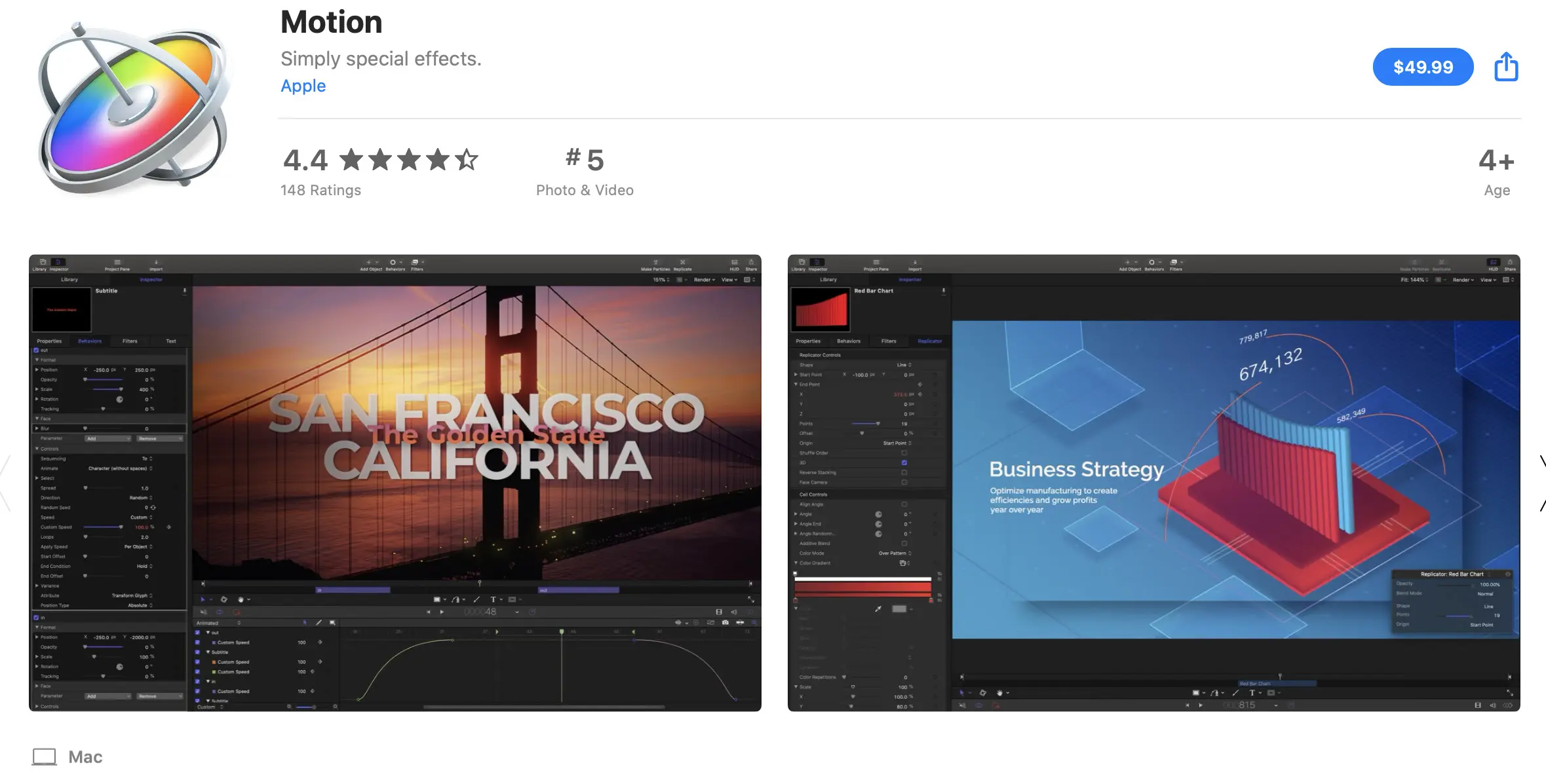
Final Cut Pro or Adobe Premiere • Apple Motion
Final Cut Pro is supported by Apple Motion — a motion graphics tool used for creating “cinematic 2D and 3D titles, fluid transitions, and realistic effects in real time.” Motion is a one-time purchase, currently priced at $49.99.
Adobe Premiere Pro is supported by Adobe After Effects – a motion graphics and visual effects software used for creating “cinematic movie titles, intros, and transitions.” Premiere Pro is available as part of Adobe’s Creative Cloud or for an annual subscription at a monthly cost of $20.99.
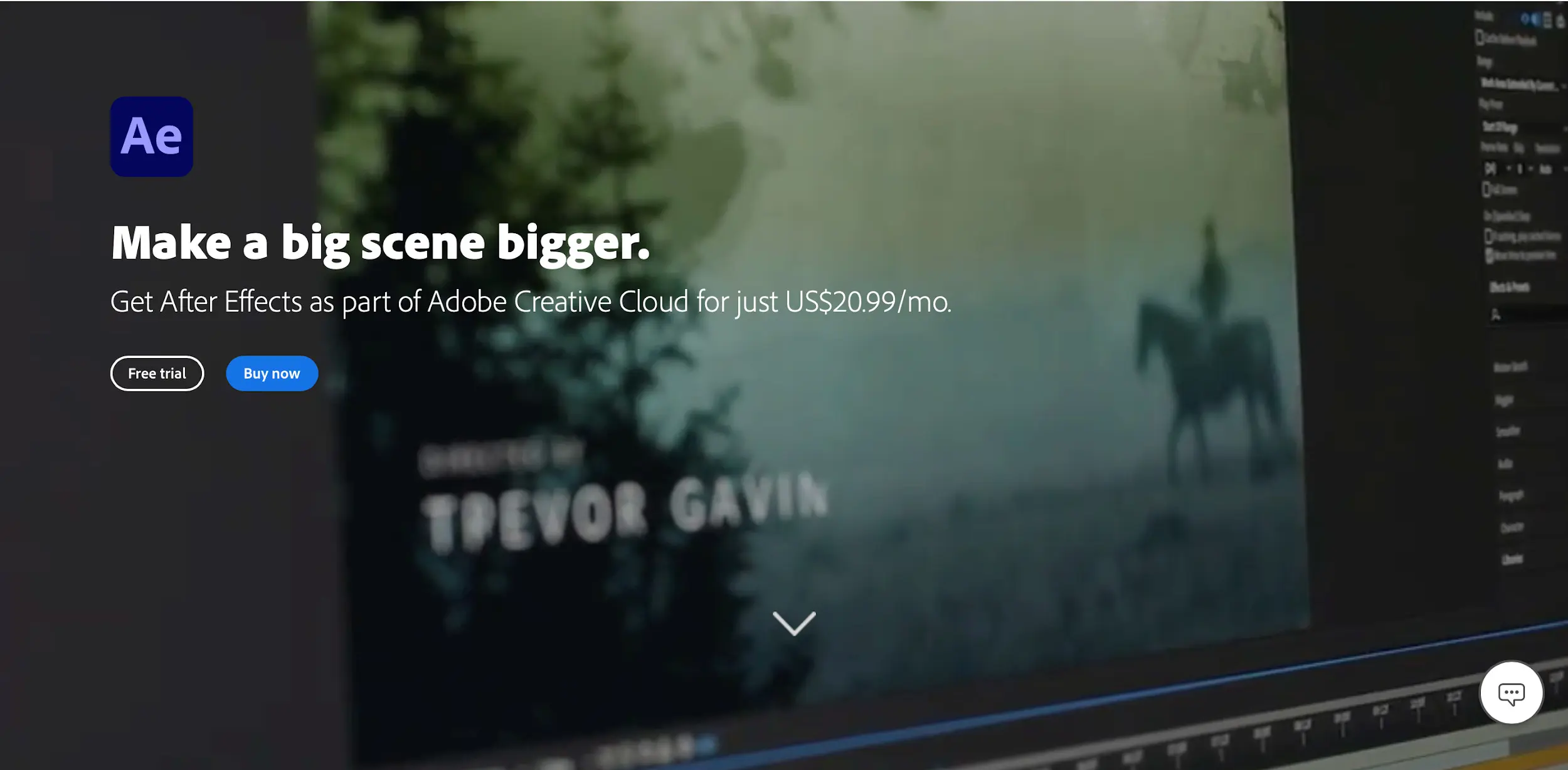
Final Cut Pro or Adobe Premiere • Adobe After Effects
After Effects is regarded as the industry standard software for titles, transitions and effects — but it’s far more difficult to use, and it’s a lot more expensive than Apple Motion.
If you’re familiar with After Effects and need its specific features for your workflow, then there’s no contest — After Effects is the clear winner.
But I’ll say this: if you’re new to the video editing game, then go with Motion. It has a far lower barrier to entry and it still offers many of the same benefits as After Effects.
Overall Winner: Tie (depending on your workflow needs)
Final Cut or Premiere Audio
Final Cut Pro vs Premiere Pro color & audio tools
I don’t think many editors would argue that Premiere Pro has better audio control than Final Cut Pro. This next video explores some of the benefits of Premiere Pro’s extensive audio editing suite.
Audio in Final Cut Pro vs Premiere Pro
On the other hand, Final Cut Pro consistently receives high marks for its intuitive color grading options. Let’s look at a video that compares color grading vs. color correction in these two programs.
Color in Final Cut Pro vs Premiere Pro
Sometimes, color issues can be fixed with software updates. Other times, it’s not the software’s fault – so just be mindful that there are a multitude of reasons for why colors don’t look like they should in Premiere Pro or Final Cut Pro. All in all, it’s hard to rate one program over the other. Premiere Pro offers more customizability, but that doesn’t mean it’s more efficient.
Overall Winner: Tie
Difference Between Premiere Pro and Final Cut Pro
Final Cut vs Premiere conclusion
Adobe Premiere Pro and Final Cut Pro X are both great programs for professional-grade video editing. Both programs will give you access to a huge suite of tools, varied formatting options, and compatibility with other programs. But is Adobe Premiere better than Final Cut Pro?
If you’re exclusively using a device with Mac OS, I’d recommend going with Final Cut Pro X. It’s a better value, and it generally works more intuitively than Premiere Pro.
If you’re exclusively using a device with Windows, I’d recommend going with Premiere Pro. There are other Windows options, but Premiere Pro still offers the best value, even though it’s exorbitantly overpriced.
If you’re using Mac OS and Windows, I’d recommend Final Cut Pro X — just keep in mind that Premiere Pro is available on both platforms.
UP NEXT
Best Video Editing Apps
Looking to take your video editing on the go? There are a lot of great options for mobile editing nowadays. Check out our next article to see how we ranked the best video editing apps. We’ll show you the best video editing apps for iOS and Android so that you can find the perfect app for your workflow needs.
Up Next: Editing apps →
Showcase your vision with elegant shot lists and storyboards.
Create robust and customizable shot lists. Upload images to make storyboards and slideshows.
